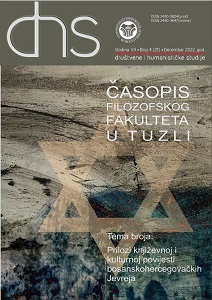JEVREJSKE VJERSKE ŠKOLE U SARAJEVU DO 1941. GODINE: SARAJEVSKA SEFARDSKA JEŠIVA (LA YESHIVA DE SARAY) I JEVREJSKI SREDNJI TEOLOŠKI SEMINAR U SARAJEVU (EL SEMINARIO RABINIKO SARAYLISKO)
JEWISH RELIGIOUS SCHOOLS IN SARAJEVO UNTIL 1941: THE SEPHARDIC YESHIVA OF SARAJEVO (LA YESHIVA DE SARAY) AND THE JEWISH SECONDARY THEOLOGICAL SEMINARY IN SARAJEVO (EL SEMINARIO RABBINIKO SARAYLISKO)
Author(s): Stevan MilovanovićSubject(s): Cultural history, Social history, Jewish Thought and Philosophy, History of Judaism, History of Education, Sociology of Education, Sociology of Religion
Published by: Filozofski fakultet Univerziteta u Tuzli
Keywords: Sarajevo; Bosnia and Herzegovina; Sephardi; Yeshiva; religious school;
Summary/Abstract: In Sarajevo, since the formation of the Jewish religious community, the religious education of children has developed simultaneously. First, four-grade elementary schools, where mostly male children went, came forward. Later in the 17th century, Talmud-Torah secondary school was developed, while Yeshiva was only formed in the second half of the 18th century. Until the establishment of the Belgrade Yeshiva by Rav Yehuda Lerma in 5395 (1635) and the Sarajevo Yeshiva by Rav David Pardo in 5528 (1768), there were no rabbinical schools in the territories of the Western Balkans and neither rabbis. In the Kingdom of Serbs, Croats, and Slovenes, later the Kingdom of Yugoslavia, there was a need for qualified personnel for the religious education of Jewish children and youth according to general laws, in lower and secondary schools. On June 13, 1928, the Jewish Secondary Theological Seminary was opened, which began operating on November 25, 1928. The Seminary operated until 1941, when it was closed on April 6 by Nazzi Germans. The paper aims to present the development of Jewish religious education from the arrival of Sephardim to Sarajevo in the 16th century until 1941. To show the importance of the development of rabbinic and Talmudic studies in Bosnia and Herzegovina, as well as the reputation of Sarajevo's Jewish religious schools in Europe and the world.
Journal: DHS-Društvene i humanističke studije: časopis Filozofskog fakulteta u Tuzli
- Issue Year: XXI/2022
- Issue No: 21
- Page Range: 187-196
- Page Count: 10
- Language: Serbian

